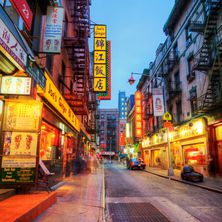

Bordered by the Civic Center in the south, Tribeca in the west , the Lower East Side in the east and Little Italy in the north, Chinatown in Manhattan is the largest concentration of Chinese people outside of China in the Western Hemisphere. It is also one of the oldest Chinese enclaves outside of Asia and the largest Chinatown neighborhood in New York City, with almost 100,000 Chinese living in the area and speaking the Cantonese and Mandarin dialects. There are also four Chinatowns in the borough of Queens, three in Brooklyn, one in East Harlem and several in Long Island. Overall there are 520,000 Chinese people living in New York City.
The Chinese started coming to New York from the American west coast in the second half of the 19th century. Facing an increasing amount of racial discrimination they felt that New York was a more tolerant, as well as a more lucrative habitat. Mott, Pell and Doyers Streets were the first streets to be settled by the new arrivals. The first Chinese New Yorkers slept on bunk beds in boarding houses and worked for cigar monopolist Ah Ken, the first Chinese person to migrate to New York.
In 1882 the US government passed the Chinese Exclusion Act, which prohibited the immigration of Chinese workers to America. The Act was repealed only in 1943, having significantly curbed the growth of the Chinese population in the country.
Life in Chinatown was harsher than in other non-American urban enclaves. While Italian, Irish, German and Polish immigrants, for example, were closer to America culturally - they were Christians and originated in Europe as had the Dutch and English colonists, the Chinese came from a completely unknown region of the world for Americans and could not identify with the Western way of life. Therefore, when the European immigrants began leaving their enclaves and gradually integrating into American life, the Chinese remained in their ethnic neighborhoods, forming closer bonds. These bonds transformed into clans that had their own territories, their own hierarchy and their own street gangs. However, although there was a criminal element in these clans, they were very helpful to the Chinese immigrants who constantly poured into New York and could not be aided, for cultural and political reasons, by the city's official authorities.
Chinatown witnessed its biggest influx of immigrants after 1965, when the US passed the Immigration and Nationality Act, which opened the borders to immigrants with particular skills or those who had family relationships with American citizens or residents. In the 70s the Chinese were joined by immigrants from Hong Kong and Taiwan, thus diversifying Chinese culture and dialects. Chinatown began to spread north over Canal Street. In the 80s, if you wanted to save money on something - whether it was a shirt, a mattress or a TV - and you lived in New York City or northern New Jersey, you would go to Chinatown. The neighborhood had everything, and it had it cheap. Mott Street also had a couple of excellent Chinese restaurants, the most famous of which was the Peking Duck.
In the 90s the more affluent Chinese residents moved out of Chinatown to other parts of Manhattan or prestigious zones if Brooklyn, or even upstate. Then in the 2000s Manhattan real estate prices sharply went up, a phenomenon that surprisingly hit Chinatown as well, and also caused the poorer Chinese to move out, only far from Manhattan. Today the neighborhood is still crammed with Chinese stores, restaurants and services, but there are not as many Chinese residents as there were in the 80s, the commercial heyday of the area.